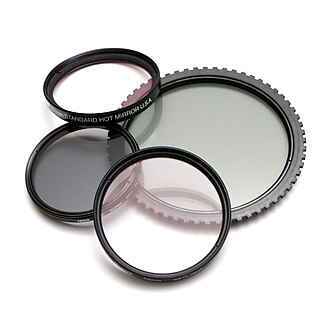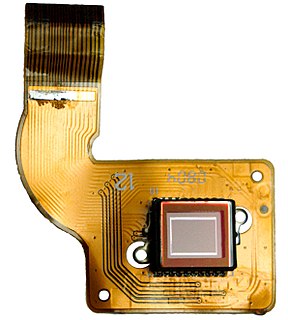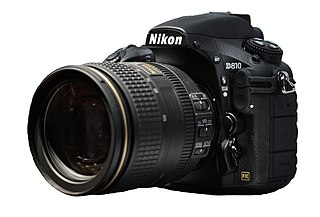
Interlaced video is a technique for doubling the perceived frame rate of a video display without consuming extra bandwidth. The interlaced signal contains two fields of a video frame captured at two different times. This enhances motion perception to the viewer, and reduces flicker by taking advantage of the phi phenomenon.

Lens flare refers to a phenomenon wherein light is scattered or flared in a lens system, often in response to a bright light, producing a sometimes undesirable artifact within the image. This happens through light scattered by the imaging mechanism itself, for example through internal reflection and scattering from material imperfections in the lens. Lenses with large numbers of elements such as zooms tend to exhibit greater lens flare, as they contain a relatively large number of interfaces at which internal scattering may occur. These mechanisms differ from the focused image generation mechanism, which depends on rays from the refraction of light from the subject itself.

Infrared cut-off filters, sometimes called IR filters or heat-absorbing filters, are designed to reflect or block mid-infrared wavelengths while passing visible light. They are often used in devices with bright incandescent light bulbs to prevent unwanted heating. There are also filters which are used in solid state video cameras to block IR due to the high sensitivity of many camera sensors to near-infrared light. These filters typically have a blue hue to them as they also sometimes block some of the light from the longer red wavelengths.

In photography and cinematography, a filter is a camera accessory consisting of an optical filter that can be inserted into the optical path. The filter can be of a square or oblong shape and mounted in a holder accessory, or, more commonly, a glass or plastic disk in a metal or plastic ring frame, which can be screwed into the front of or clipped onto the camera lens.
Flicker is a visible change in brightness between cycles displayed on video displays. It applies especially to the refresh interval on Cathode ray tube (CRT) televisions and computer monitors, as well as Plasma based computer screens and televisions.

Day for night is a set of cinematic techniques used to simulate a night scene while filming in daylight. It is often employed when it is too difficult or expensive to actually shoot during nighttime. Because both film stocks and digital image sensors lack the sensitivity of the human eye in low light conditions, night scenes recorded in natural light, with or without moonlight, may be underexposed to the point where little or nothing is visible. This problem can be avoided by using daylight to substitute for darkness. When shooting day for night, the scene is typically underexposed in-camera or darkened during post-production, with a blue tint added. Additional effects are often used to heighten the impression of night.

An image sensor or imager is a sensor that detects and conveys information used to make an image. It does so by converting the variable attenuation of light waves into signals, small bursts of current that convey the information. The waves can be light or other electromagnetic radiation. Image sensors are used in electronic imaging devices of both analog and digital types, which include digital cameras, camera modules, medical imaging equipment, night vision equipment such as thermal imaging devices, radar, sonar, and others. As technology changes, digital imaging tends to replace analog imaging.
In photography, exposure range may refer to any of several types of dynamic range:

The Prizma Color system was a color motion picture process, invented in 1913 by William Van Doren Kelley and Charles Raleigh. Initially, it was a two-color additive color system, similar to its predecessor, Kinemacolor. However, Kelley eventually transformed Prizma into a bi-pack color system that itself became the predecessor for future color processes such as Multicolor and Cinecolor.
A human visual system model is used by image processing, video processing and computer vision experts to deal with biological and psychological processes that are not yet fully understood. Such a model is used to simplify the behaviours of what is a very complex system. As our knowledge of the true visual system improves, the model is updated.

A LED-backlit LCD is a flat panel display which uses LED backlighting instead of the cold cathode fluorescent (CCFL) backlighting. LED-backlit displays use the same TFT LCD technologies as CCFL-backlit displays, but offer reduced energy consumption, better contrast and brightness, greater color range, more rapid response to changes in scene, and photorefractive effects.

Technicolor is a series of color motion picture processes, the first version dating to 1916, and followed by improved versions over several decades.
FPR is a technology promoted by LG that is employed in its line of 3D televisions based on circular polarization. It shows left and right images through different patterns in a circular polarizer. Left/right polarized glasses allow the left and right images to then be seen by the left and right eyes separately. Both images are combined in the brain and generate the 3D effect. The FPR technology uses the precise film which polarizes different pixels differently to show a different image for each eye. FPR 3D tech is said to deliver a brighter screen with less cross talk, less ghosting, and no flickering.
MiNT Camera is a company specializing in the Polaroid instant film cameras and its accessories. Founded in 2009, it provides products and services for instant photography. Its principal activities are the refurbishment and repair of Polaroid cameras, with two MiNT Polaroid Warranty Centers located in Causeway Bay and Kwun Tong, Hong Kong. MiNT Camera has partnered with Impossible Project, a manufacturer of instant photographic materials.

The Nikon D810 is a 36.3-megapixel professional-grade full-frame digital single-lens reflex camera produced by Nikon. The camera was officially announced in June 2014, and became available in July 2014.

The Canon EOS 5DS and EOS 5DS R are two closely related digital SLR cameras announced by Canon on February 6, 2015. Both are professional full-frame cameras with 50.6-megapixel sensors, the highest of any full-frame camera at the time of announcement. The only difference between the two models is that the sensor of the "R" version includes an optical filter that cancels out the effects of a standard optical low-pass filter. This distinction is roughly similar to that between Nikon's now-replaced D800 and D800E. Canon stated that both the 5DS and 5DS R will not replace the older EOS 5D Mark III, so therefore both the 5DS and 5DS R will have their new positions in Canon's DSLR camera lineup.

The Nikon D500 is a 20.9-megapixel professional digital single-lens reflex camera using an APS-C sensor. It was announced by Nikon Corporation on January 6, 2016 along with the Nikon D5 FX format camera. It replaced the D300S as Nikon's DX format flagship DSLR. On February 23, 2017, at CP+ show, a special edition was released for Nikon's 100th anniversary.
D500 jointly won a Camera Grand Prix Japan 2017 Editors Award.

The Nikon D5 is a full frame professional DSLR camera announced by Nikon Corporation on 6 January 2016 to succeed the D4S as its flagship DSLR. The D5 offers a number of improvements over its predecessor including a new image sensor, new image processor, improved ergonomics and expanded ISO range. Additionally, improved auto focus (AF) mode were introduced. On 23 February 2017, at CP+ show, a special edition was released for Nikon's 100th anniversary.

Windows Camera is an image and video capture utility included with the most recent versions of Windows and its mobile counterpart. It has been around on Windows-based mobile devices since camera hardware was included on those devices and was introduced on Windows PCs with Windows 8, providing users for the first time a first-party built-in camera that could interact with webcam hardware. It is similar in structure and features to the eponymous iOS and Android apps.














